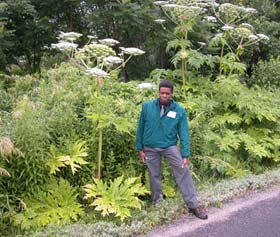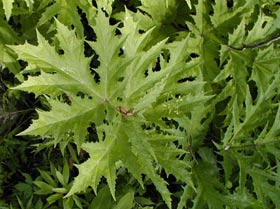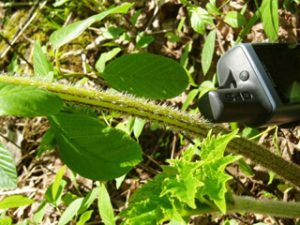
Giant hogweed. Photo by Donna Ellis.
Giant hogweed can be a threat to human health. Its sap has Furocoumarins (photosensitizing compounds) that can cause a skin reaction known as phyto-photodermatitis. This makes the skin highly sensitive to ultraviolet light. Swelling and blistering of the skin may lead to permanent scarring, and contact with the eyes can cause temporary and sometimes permanent blindness.
In Wisconsin, giant hogweed is classified as a prohibited species under the Invasive Species Rule (Wis. Adm. Code ch. NR 40). Its presence potentially causes economic or environmental harm or harm to human health. Isolated populations of Giant hogweed have been found in Wisconsin with immediate control taking place after verification.
Giant hogweed is native to the Caucasus region of Eurasia. The first record of it in North America was in 1917 in an ornamental garden in New York. It is an herbaceous, biennial plant and a member of the Apiaceae or Umbelliferae family, commonly known as the carrot or parsley family. It can live for several years but once it flowers and bears fruit it dies. It is hardy to zone 3 preferring full sun and moist, well-drained soil. Giant hogweed is identified by its:
- large compound umbel of white flowers,
- large, deeply incised leaves,
- prominent white hairs, and purple blotches on its stems.
It is often confused with other species in the family which include; cow parsnip (Heracleum lanatum) which is the most similar, angelica (Angelica atropurpurea), poison hemlock (Conium maculatum) and wild carrot (Daucus carota).

Leaves of giant hogweed. Photo by Donna Ellis.
It once was a popular ornamental plant because of its massive size and eye appeal which distinguishes it from its look-a-likes as it can grow to a height of 15 feet. Its leaves are alternately compound and unfold in early summer into deeply incised, lobed leaves measuring up to 5 feet in width. The leaflets attached higher on the stem are not quite as large and are triangular-lanceolate, and deeply cut with an alternating leaf arrangement. Giant hogweed remains in a rosette stage until it develops sufficient roots. Then it bolts and flowers, generally in its second year but that can take up to 3 to 5 years depending on soil conditions.

White hairs and purple blotching on stem of giant hogweed.
It has large, hollow, ridged stems with spikey white hairs at the nodes and base of the petiole. Stems are mostly green with white hairs, with distinctive purple blotches. Flowering late June through mid-July the flower is arranged as a compound umbel with thousands of tiny, white flowers that form a flat top with a diameter up to 2.5 feet resembling an umbrella.
If you suspect Giant hogweed please contact the DNR at Invasive.Species@wi.gov or text us a picture for verification at 608-444-6948.
Written by: Bernadette Williams, invasive plants and earthworms specialist, Madison, (bernadette.williams@wisconsin.gov), 608-266-0624.
